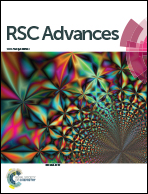A novel & effective visible light-driven TiO2/magnetic porous graphene oxide nanocomposite for the degradation of dye pollutants†
Abstract
Porous graphene oxide (pGO) was applied for the preparation of various nanocomposites, including TiO2 (anatase)/pGO, TiO2 (mix phase)/pGO, TiO2 (anatase)/magnetic pGO and TiO2 (mix)/magnetic pGO, using titanium(IV) chloride as the photocatalyst precursor. Field emission scanning electron microscopy (FESEM), X-ray diffraction (XRD), thermogravimetric analysis (TGA), Fourier transform infrared (FT-IR) spectroscopy, diffuse reflectance UV-vis spectroscopy (DR-UV-vis), and N2 adsorption–desorption using Brunauer–Emmett–Teller (BET) analysis were employed to investigate the morphology, crystal structure, surface groups, and optical properties of the prepared nanocomposites. The photocatalytic performance of the synthesized nanocomposites under visible light was investigated in the degradation of Rhodamine B (RhB) as a model organic pollutant. The TiO2 (mix)/magnetic pGO nanocomposite showed enhanced efficiency under visible light irradiation compared with the other catalysts. 100% degradation using the TiO2 (mix)/magnetic pGO nanocomposite under visible light was achieved in less than 20 min in comparison with TiO2 (mix, anatase) nanoparticles, and TiO2 (anatase)/pGO and TiO2 (mix)/pGO nanocomposites. The degradation efficiency of RhB using the stable nanocomposite remained at 85% after 10 times reuse. The highest photocatalyst performance was achieved with 0.01 g of nanocatalyst and 10 mg L−1 of RhB at pH 9 under visible light irradiation in less than 20 minutes. Moreover, the effect of various scavengers, such as methanol (OH˙ radicals scavenger), disodium ethylenediaminetetraacetate (EDTA, holes scavenger), and p-benzoquinone (BQ, O2˙− radicals scavenger), on RhB degradation was investigated.


 Please wait while we load your content...
Please wait while we load your content...